Babies everywhere call for ban on pesticides
April 22, 2011
Pesticide Exposure in the Womb
Here is the link to the Times article about pesticide exposure in the womb. Basically, 3 separate studies show that school-age children who were exposed to pesticides in the womb have lower IQs. Yet another reason to choose your food carefully and cook at home more often!
When cooking for my family, I realize the benefit of organic; but, it is not always available, in the budget, or as fresh as local produce. As the Times article suggests, I use the Dirty Dozen and Clean 15 lists put out by the Environmental Working Group (EWG) as a guide and my recipes reflect this. In addition to organic produce, I also recommend organic dairy, pasture-raised meats, and eggs from pastured birds whenever possible.
A Frozen Fillet a Day…
December 10, 2009
Growing up in lovely land-locked Oklahoma, fish “previously frozen” was par for the course at the local grocery and ultimately what ended up on our dinner plates. Mom mostly avoided the fish sticks and opted for “nice Orange Roughy filets” (only recently did I discover this fish is incredibly unsustainable and we probably contributed a tiny bit to wiping out a species–they didn’t tell you ANYTHING in the 80’s).
Choosing healthy, sustainable seafood with low carbon footprints and few contaminants can be one of the most daunting endeavors at today’s market. The link above is to a piece in the NY Times about a responsible approach to eating fish. It involves a little defrost, but not much compromise on taste or cost. Also, when shopping look for the Marine Stewardship Council’s label (above), which means the fish has been certified sustainable. Definitely forgo the Orange Roughy and try some of these sustainable seafood options, low in mercury and PCBs, and safe to eat at least once a week*:
- Wild Alaskan salmon (NOT farmed Atlantic salmon)
- Rainbow trout (farmed)
- U.S and Canadian Albacore tuna
- Black Seabass
- Clams
- Anchovies
- Dungeness, King (U.S), and snow crab
- Crawfish
- U.S and Canadian Herring
- Farmed oysters
- Alaskan pollock
- Canned salmon
- Canned light tuna
- Sardines
- Scallops
- U.S and Canadian shrimp
- U.S and Latin American tilapia
*For adults 18-75 years old. Children are advised to eat these less often, 2-4 times a month depending on the species. For more information on the above, click on: Environmental Defense Fund
‘Tis the Season(s) for THE DUMPLING
November 11, 2009
 Several summers ago, chef Wai Hon Chu approached me to test 90+ recipes for a cookbook project with fellow chef and writer Connie Lovatt. Wai and Connie introduced me to the definition of a dumpling, “…a portion of dough, batter, or starchy plant fare, solid or filled, that is cooked through wet heat, and is not a strand or a ribbon.”
Several summers ago, chef Wai Hon Chu approached me to test 90+ recipes for a cookbook project with fellow chef and writer Connie Lovatt. Wai and Connie introduced me to the definition of a dumpling, “…a portion of dough, batter, or starchy plant fare, solid or filled, that is cooked through wet heat, and is not a strand or a ribbon.”
So, wet heat (literally) was what I worked through that summer, learning that sticky toffee pudding and Mexican tamales are actually dumplings! And that I’m a huge fan of dropped dumplings (a Grunt and Cocky’s Joy come out on top for flavor and funny names). And I learned that my supportive husband, then fiance, will try anything I cook; although, we’re both still suspicious of tripe.

Single-Husked Tamale Fold
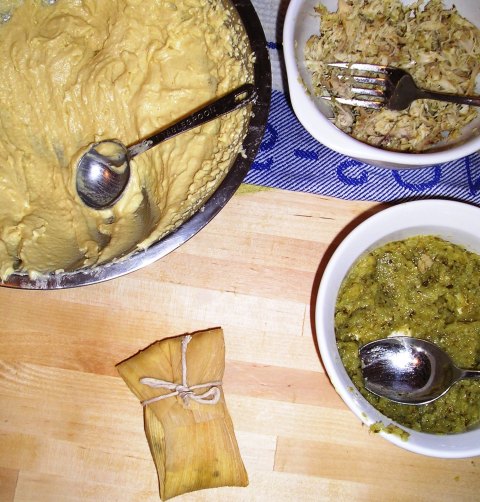
Tamales Stuffed with Chicken and Tomatillo Sauce--Tamales de Pollo (Mexico)

Wontons with Red Chili Oil--Hung You Chao Shou (China)
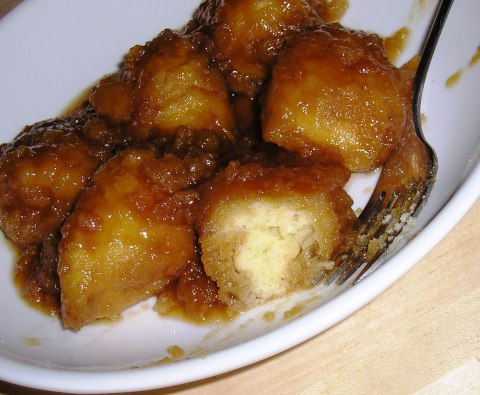
Dumplings and Cocky's Joy (Australia)

Country Cabbage Soup with Large Cornmeal Dumplings--Soupe aux Miques et aux Choux (France)

Pumpkin and Lentil Ravioli with Browned Butter and Rosemary--Ravioli di Zucca e Lenticchie (Italy)
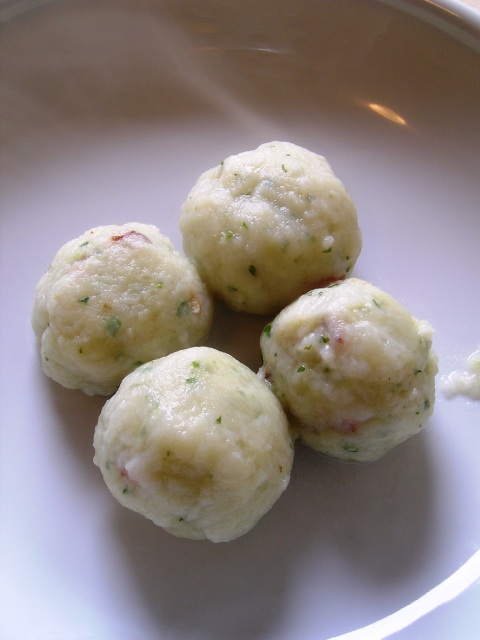
Potato Dumplings with Crouton Centers--Kartoffelklosse (Germany)

Potato Dumplings Stuffed with Ham, with Ligonberry Jam--Kroppkakor (Sweden)
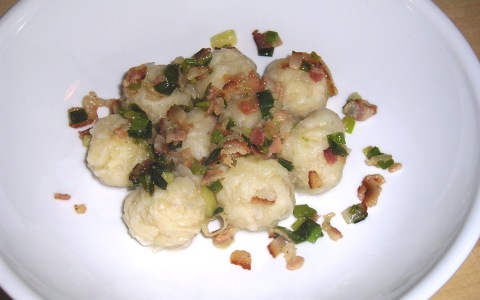
No-Fuss Potato Dumpling with bacon and onion--Pyzy (Poland)
Kids Don’t Stop Learning During Lunch
September 30, 2009
Kids are like sponges, am I right? So they don’t stop absorbing their environment when they leave the classroom for the cafeteria. Unfortunately, the message that children must be sopping up in cafeterias across the U.S. is that time, convenience–and money–are more highly valued than health.
So, yet another obstacle in feeding kids healthy food: there are no kitchens in the schools. Over the last few decades, as parents gradually replaced hot meals at home with Hot Pockets, so did school systems. Check out Kim Severson’s piece in today’s NY Times Dining & Wine section:
Agribusiness, Health Insurers: Take Your Corners!
September 12, 2009
Michael Pollan’s response to Obama’s health care speech–snippets from his NY Times op-ed:
“A patient with Type 2 diabetes incurs additional health care costs of more than $6,600 a year; over a lifetime, that can come to more than $400,000. Insurers will quickly figure out that every case of Type 2 diabetes they can prevent adds $400,000 to their bottom line. Suddenly, every can of soda or Happy Meal or chicken nugget on a school lunch menu will look like a threat to future profits.”
“AGRIBUSINESS dominates the agriculture committees of Congress, and has swatted away most efforts at reform. But what happens when the health insurance industry realizes that our system of farm subsidies makes junk food cheap, and fresh produce dear, and thus contributes to obesity and Type 2 diabetes? It will promptly get involved in the fight over the farm bill — which is to say, the industry will begin buying seats on those agriculture committees and demanding that the next bill be written with the interests of the public health more firmly in mind.”
Check out the full article below:
Veggie Rehab
August 17, 2009

Obesity and over-crowded prisons. Both big problems.
This NY Times piece (article link below) got me thinking about a new course for rehabilitation and correction programs in this country. An approach that could possibly tackle the bulging waistlines issue as well. At Renewal Farm in Garrison, NY, recovering addicts are growing over 1200 pounds of food annually for a local country club (in exchange for land); but, what if they were growing for local schools and other community non-profits?
The dollars spent on rehabilitating these individuals could come back to the community in the form of healthy meals for children and seniors. And program participants could receive culinary job training. Does anyone know of other programs where recovering addicts or inmates are growing food for the communities in which they live?
The Secret to Michelle Obama’s Arms?
May 31, 2009
Is apparently not kneading and whisking.
A quote and link to Amanda Hesser’s Op-Ed piece is below (Chef Anne Cooper once again tweets a great link!).
“As we lost our skills at the stove, we also lost something less tangible but no less important: the opportunity to spend time together in the kitchen, talking and cooking. Similarly, we gave up the chance to improve our children’s eating habits by example.”
Handiwork
May 28, 2009
The Case For Working With Your Hands
Thinking of quitting that desk job and getting a little dirt under the fingernails? Check out this article from the Times–thanks to Chef Ann Cooper for posting!
Head of Lead-uce?
May 15, 2009
Tending an urban garden? Don’t miss this article on soil contamination and testing.
Big Dose of Green!
April 22, 2009
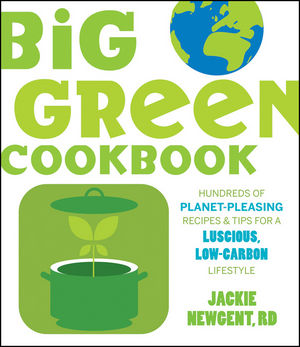 In honor of Earth Day, I wanted to mention the release of Big Green Cookbook, by fellow RD Jackie Newgent. I spent several weeks last summer testing recipes in Jackie’s Brooklyn kitchen, and was excited to receive my signed copy last week. Congrats Jackie!
In honor of Earth Day, I wanted to mention the release of Big Green Cookbook, by fellow RD Jackie Newgent. I spent several weeks last summer testing recipes in Jackie’s Brooklyn kitchen, and was excited to receive my signed copy last week. Congrats Jackie!
The focus here is on low-carbon, from the food sources (local, seasonal, sustainable) to the cooking methods (limited cooking times, using small appliances). So grab a recycled tote, buy from local farmers, plug in (and then unplug) your toaster oven and get cooking!
Some of my favorites made it into the book, so be sure to check out the Blueberry Crumble Bars, Autumn Black Bean Salad, and Organic Burger Bites (complete with “special sauce”). You won’t be disappointed.
Celebrate Earth Day by clicking below to purchase the book on Amazon and treat yourself to good for you-and-earth recipes.
